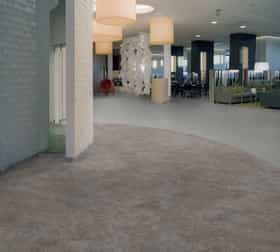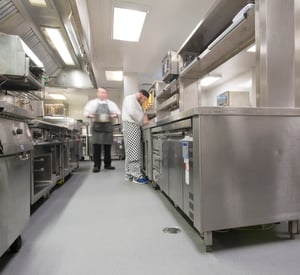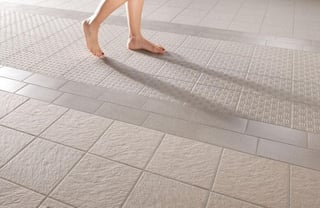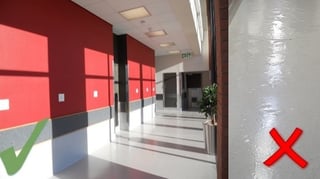Vinyl
|
Ceramic Tiles
|
Design versatility
|
-
Vinyl offers a vast range of flooring products, from sheet flooring to luxury vinyl tiles (LVTs), in a range of very realistic stone and wood looks
-
Large variety of colours
-
Malleability makes designing and branding easy for any look and feel

|
 |
Warmth
|
|
|
-
Cold
-
Natural-stone ceramic tiles are cold underfoot and often store the cold absorbed overnight or during cold periods
-
Generally only store warmth if exposed to a heat source, usually from above, such as direct sunlight
|
Softness
|
-
A resilient floor, which is soft underfoot
-
For a high degree of softness, choose a heterogenous vinyl floor with a wear layer and a 2 – 3.7mm foam under layer
-
If good shock and sound absorption are required as well, e.g. where staff are on their feet all day, use a 3.7mm foam under layer
|
|
Acoustic properties
|
-
NRC (noise reduction coefficient) measures the amount of noise that is absorbed, rather than reflected, by a material. It is referred to as the ‘sound bounce’ of a floor
-
Whilst carpet has the highest NRC rating, vinyl is also highly rated
-
As a resilient floor, it allows much less sound bounce than hard floors such as ceramic, cement, stone and porcelain. It will therefore substantially reduce the ‘clutter noise’ in hospital corridors, hotel foyers, shops, banks, etc.
-
Particularly useful in multi-storey buildings, specialised acoustic vinyl floors can offer a noise reduction level of up to 19dB. This refers to sound transmission so the maximum effect is felt not in the room in which it is laid, but in the space below
|
|
Slip resistance
|
-
The slip resistance of a standard vinyl floor is likely to be similar to the slip resistance of a standard ceramic tile when dry and considerably better when wet
-
Specialised non-slip vinyl safety floors are available
-
A sustainable, slip-resistant safety floor should always achieve a Pendulum Test Value (PTV) of 36 or more (in wet conditions), using 4S rubber/Slider 96. An in-use PTV of 36+ classifies the floor as having a low slip-potential, and equates to the potential for one person in a million to slip on the floor
-
IMPORTANT: Beware of pendulum-test results only conducted in dry conditions
-
Some (not all) slip-resistant vinyl floors have a cross-linked and UV-cured polyurethane reinforcement (PUR) coating which facilitates easy cleaning and ensures longevity of the slip-resistant properties
 |
-
Available in a textured non-slip finish
-
For tiles made from a porous/absorbent material with good drainage, a non-slip coating can add to their slip resistance
-
Check how long the slip resistance is expected to last
-
Ask for pendulum-test results in both dry and wet conditions
 |
Floor shine
|
-
Whilst shine used to be regarded as an indication that a floor was clean and in good condition, recent research suggests otherwise. A shiny floor is not necessarily clean, and it is less comfortable for walkers. The brain perceives the shiny floor as slippery and adjusts accordingly, leading to greater fatigue than when walking on a more matte floor
-
Retailers should think carefully before installing a shiny floor in shops and walkways if they want shoppers to maintain focus and not tire
|
Hygiene properties
|
-
Excellent floor of choice in healthcare and hygiene critical areas i.e. kitchens, because sheeting is hot welded to form a seamless and impervious floor surface where bacteria cannot find space to thrive. LVTs are laid without a grouting space to ensure a hygienic surface.
-
Easy to clean
-
Dry cleaning is sufficient for PUR-coated tiles (bacteria thrive on warmth, moisture, dust and grit, which means that wet cleaning can provide the ideal environment for bacteria to spread)
|
-
Best used in areas where hygiene is not of primary importance
-
Textured non-slip tiles tend to trap dirt
-
Dirt and germs collect in grouted areas, which are difficult to keep clean and hygienic
-
Some ceramic tiles can be laid without grouting and specialised germ-and grease-resistant grouting is available, but the joins remain a challenge for infection control
|
Eco-friendliness
|
-
Product and production dependent
-
Many top-quality vinyl products are very eco-friendly across the full chain of production and use. PVC can be recycled many times over.
-
Most reputable manufacturers use environmentally sound production methods and most top-end manufacturers use raw materials in an environmentally sensitive way
-
Ask the vinyl manufacturer to provide their sustainability information and credentials
|
-
Product and production dependent
-
Many ceramic tiles are very eco-friendly across the full chain of production and use
-
Ask the ceramic-tile manufacturer to provide their sustainability information and credentials
|
Durability
|
|
|
|
Cleaning regime
|
-
Easy to sweep and mop
-
Resistant to staining
-
A good-quality vinyl floor with PUR coating reduces maintenance costs by 48%, offering polish/sealer-free maintenance over a lifetime of 20 years or more
-
Dry cleaning methods are sufficient, making day-to-day cleaning cheaper and more efficient than in areas where wet cleaning is required

|
-
Easy to sweep and mop
-
Some have excellent stain-resistant qualities
-
Difficult to clean grout properly
-
Wet cleaning increases risk of slippage
-
Re-sealing may be required
|
Sub-floor requirements
|
-
As vinyl is a thin, impervious product, the sub-floor needs to be dry, strong, hard, level and smooth
-
Cannot generally be installed over another floor without a 5mm self-leveling screed
-
Depending on the sub-floor’s moisture content, a moisture barrier may also be required
- The sub-floor should always be prepared by an expert vinyl installer. The difference between a well-prepared sub-floor and a poorly prepared sub-floor is obvious in the pictures below:

|
-
Sub-floor should be dry, strong, hard and level
-
Can be installed over other floor products if a good-quality coating product is used but, as with all floors, the top floor covering is dependent on the condition of the sub-floor
|
Sub-floor costs
|
-
Concrete slab: R250–350/m2 (for new lay)
-
Screed self-leveler: R145/m2 (5mm thickness always recommended)
-
Moisture barrier: R65/m2 (may not be necessary, depending on the sub-floor’s moisture content)
|
|
Installation costs
|
|
|
|
Installation time
|
-
Two days to apply and dry moisture barrier
-
One day for self-leveler application and drying time
-
One fitter can install 100m2 per day
-
Preferably no other contractors on site during installation
-
Where installation time is critical, choose vinyl products which do not require adhesive and can be loose laid
|
-
One day to apply and dry self-leveler
-
One layer can lay 25–30m2 per day
-
Other contractors may be on site during installation
|
Product costs (2019/2020)
|
-
Homogeneous vinyl sheeting: R200–R450/m2
-
Heterogeneous vinyl sheeting: R350–R450/m2
-
LVTs: R300–R600/m2
-
Acoustic floor: R400/m2
-
Anti-slip safety floor: R300–R450/m2
-
Rubber range for back-of-house (heavy-wheeled traffic): R600–R1000/m2
-
Loose lay vinyl: R300 - R670/m2
|
|
Maintenance costs
|
|
|
|
Replacement costs
|
-
Difficult to damage
-
A well-trained fitter should be able to replace damaged LVTs
-
If vinyl sheeting is damaged, a patch can be welded in but, as with all floors, the replacement will be noticeable
-
If a patch will be unsightly, a complete drop can be installed in various ways, depending on the design and layout of the product
|
|